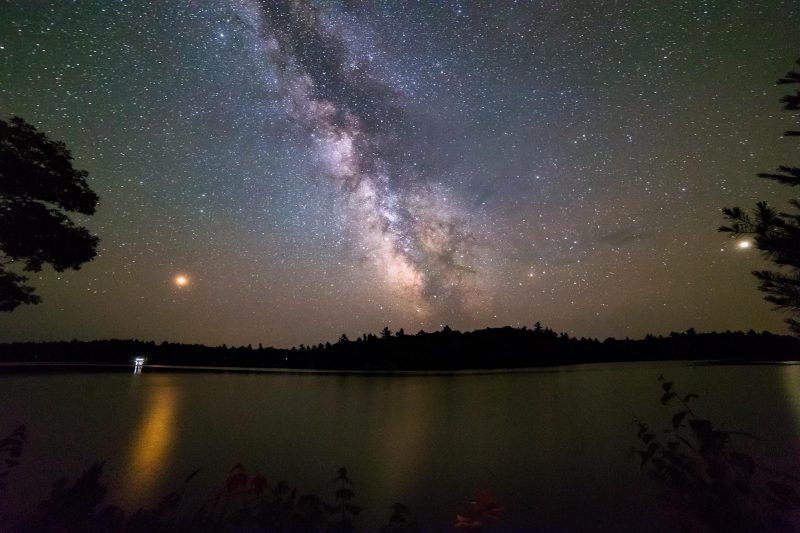What does your night sky look like? Can you see our own galaxy, the Milky Way, with its brown dust clouds and concentrated starlight?
For anyone living in all but the smallest of towns, the answer to the latter is likely “no.” With how common artificial light is in all aspects of modern life, one must now go far from civilization to find a pristine, truly dark sky. These precious dark areas, away from light pollution, reveal the stark contrast between the night skies most are accustomed to in cities and the true experience of a naturally dark night sky.
This range of night skies, from dark to bright, was categorized into an easy-to-follow scale by John Bortle as the “Bortle Dark-Sky Scale,” or simply the Bortle scale. It was first introduced in the February 2001 edition of the Sky & Telescope magazine, and it remains just as relevant today. As the Bortle scale celebrates its 20th anniversary, it’s a great time to take a look at it again and think about what we can do to reduce light pollution.
“To help observers judge the true darkness of a site, I have created a nine-level scale. It is based on nearly 50 years of observing experience. I hope it will prove both enlightening and useful to observers — though it may stun or even horrify some! Should it come into wide use, it would provide a consistent standard for comparing observations with light pollution. Researchers would also be better able to assess the plausibility of an unusual or marginal observation. All around, it could be a boon to those of us who regularly scan the heavens.”
John E. Bortle, Sky & Telescope, February 2001
The scale
The Scale ranges from Class 1 to Class 9, with 1 being the darkest and 9 being the brightest.
CLASS 1: EXCELLENT DARK-SKY SITE
CLASS 2: TYPICAL TRULY DARK SITE
CLASS 3: RURAL SKY
CLASS 4: RURAL/SUBURBAN TRANSITION
CLASS 5: SUBURBAN SKY
CLASS 6: BRIGHT SUBURBAN SKY
CLASS 7: SUBURBAN/URBAN TRANSITION
CLASS 8: CITY SKY / CLASS 9: INNER-CITY SKY
Both Classes 1 and 2 are what you would find in places like RASC Dark-Sky Sites, with Class 1 being the best examples of dark skies possible, and Class 2 being typical dark-sky sites. In the 2001 article, Bortle says a person would be able to see magnitude 7.6 to 8.0 objects with effort in a Class 1 sky, while objects as faint as magnitude 7.1 to 7.5 could be seen in a Class 2 sky. In both classes, you’d be able to see the zodiacal light.
Classes 3 to 6 span the transition from rural to bright suburban skies. Class 3 skies would have a naked-eye limiting magnitude from 6.6 to 7.0. In a Class 4 sky, the naked-eye limiting magnitude would be 6.1 to 6.5, and you shouldn’t expect to see anything fainter than magnitude 5.6 to 6.0 in a Class 5 sky. Bortle suggests the naked-eye limiting magnitude in a Class 6 sky would be 5.5.
Classes 7 to 9 span from urban to the brightest inner-city skies. He suggests the naked-eye limiting magnitude is 5.0 for Class 7, 4.5 for Class 8 and 4.0 or less for Class 9.
This system provides a simple way to describe how dark a location’s sky is, especially for the means of comparison or discussion of if a site is dark enough for a given purpose — like amateur astronomy. The wonders of the stars and nearby galaxies are best seen under dark skies, where you can pick out naked-eye Messier objects and zoom in on faint deep-sky objects with binoculars and telescopes.
Looking for the Bortle class of a particular area? Built by Jurij Stare using data from the The New World Atlas of Artificial Night Sky Brightness, LightPollutionMap.info has produced a clickable map, where the Bortle class can be seen for particular co-ordinates on a map.
Night lights’ effects on nature
Perhaps even more importantly though is the protection of night ecology, the flora and fauna which relies on darkness at night. Artificial light interrupts the natural rhythms of some lifeforms, and this has a serious environmental impact beyond energy consumption and greenhouse gas emissions.
We should all endeavour to do what we can to reduce light pollution and move down the Bortle Scale — for our own enjoyment and for the health of the planet.
How has your night-sky changed over the years? Let us know at editor@skynews.ca.




